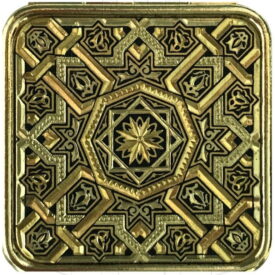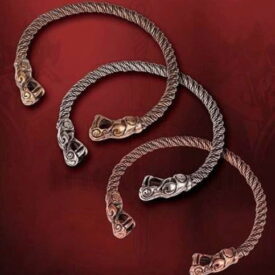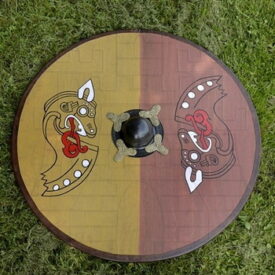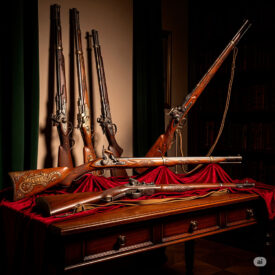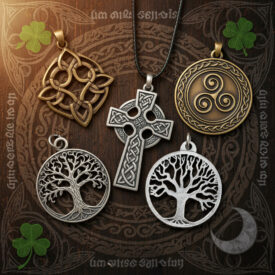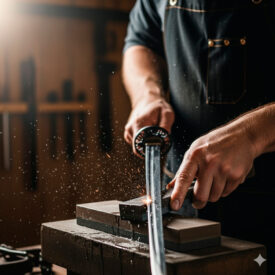What mystery can hang from the neck and, at the same time, unite the mundane with eternity? Egyptian pendants do just that: they are amulets that speak of kings, gods, and journeys to the Afterlife, pieces that condense an entire cosmology into a few centimeters of gold, faience, or stone.
This article guides you through the history, symbolism, and techniques that forged these talismans. You will learn how they were interpreted, what materials and colors were used, and how modern archaeologists decipher their function thanks to advanced technologies. By the end, you will have a complete overview to recognize the most important motifs and understand why these pendants continue to inspire contemporary design.
The Historical Scene at a Glance: Essential Chronology
Before delving into symbols and techniques, it is convenient to place the evolution of Egyptian jewelry on a timeline. Chronology helps to understand why certain motifs appear, disappear, or transform throughout the centuries.
| Period | Events and Evidence |
|---|---|
| Predynastic Period (c. 4000 BC and earlier) | |
| c. 4000 BC | First evidence of jewelry manufacturing; objects with apotropaic purposes already integrated into funerary goods. Badarian Era: early glass pieces, e.g., necklace of small blue beads on multiple strands. |
| Early Dynastic Period (Dynasties I-II) | |
| First Dynasty | Varied production of fine jewelry (necklaces, bracelets) with diverse materials and techniques. 1901: in Djer’s tomb, four bracelets of gold, lapis lazuli, turquoise, and amethyst were found next to the arm of a mummified woman. |
| Old Kingdom (Dynasties III-VI) | |
| General | Use of Eye of Udjat amulets in jewelry and funerary contexts. From the 6th Dynasty, funerary necklaces of vitreous composition and gold are preserved, like Impy’s, finished in blue and with 63 scarab-shaped pendants, with his name on gold tips. |
| Middle Kingdom (Dynasties XI-XIII) | |
| General | The scarab becomes popular as a central amulet; the finest works are produced in harmony and choice of materials and colors. Examples: Khnumet’s pendant (granulated gold and vitreous composition), Senebtisy’s bead belt (23 vertical strands of beads). |
| Discoveries | 1894: treasure of Princess Khnumit in Dahshur (necklace of 6 strands of gold pearls and numerous precious stones). 1914: tomb of Princess Sithathoriunet in El-Lahun with a diadem, bracelets, and pectorals of high quality. |
| New Kingdom (Dynasties XVIII-XX) | |
| General | Height of amulets and democratization of funerary practices; strong rise in the use of glass in jewelry. |
| Thutmose III | High-quality jewelry: bracelets, necklaces with fish and glass beads; wigs and diadems with rosettes inlaid with colored glass in wives’ tombs in Thebes. |
| Tutankhamun (18th Dyn.) | Culminating point of New Kingdom jewelry: in his tomb more than 140 apotropaic objects (about 30 true amulets). Noteworthy pectorals: vulture with ~300 glass inlays, pectoral with full moon and solar bark, pectoral with winged falcon, shen, and ankh. Gold funerary mask inlaid with turquoise, lapis lazuli, and carnelian. |
| Dynasty XIX–XX | Important pieces with vitreous inlay (e.g., Ramesses II’s falcon pectoral in the Serapeum). From the 20th Dynasty, the “two fingers” amulet appears. |
| Third Intermediate Period and Late Period (Dynasties XXI-XXXI) and Greco-Roman Period | |
| General | Work with glass continues to be abundant; pieces by Pharaoh Psusennes stand out. Significant increase in the number of funerary amulets during the Late Period and the Ptolemaic period (some mummies with up to one hundred amulets). |
| Dynasty XXII | Amulets are arranged on networks of faience beads that covered the body; new types appear such as the winged scarab and the Sons of Horus. Reign of Sheshonq: conical gold bracelets with lapis lazuli and glass inlays; lapis lazuli scarab pectoral with solar disk. |
| Greco-Roman Era and Modern Studies | Textile amulets and plaques with representations have been found (Eye of Udjat, Sons of Horus). Computed tomography (CT) has allowed “unwrapping” intact mummies virtually and locating amulets without damaging them, confirming the symbolic placement of the objects (e.g., analysis of Nespamedu’s mummy with high-resolution CT). |
Why Pendants Were More Than Just Jewelry
In Ancient Egypt, the separation between the material and the divine was fragile: an amulet could become a link between a mortal and a deity. A pendant was not just an ornament; it was a ritual tool, a seal of identity, a physical and spiritual protection.
Egyptians spoke in symbols. A lapis lazuli ring didn’t just shine: it spoke of royalty. A fragment of green faience didn’t just decorate: it invoked regeneration. This symbolic reading permeated the choice of motifs, materials, and colors.
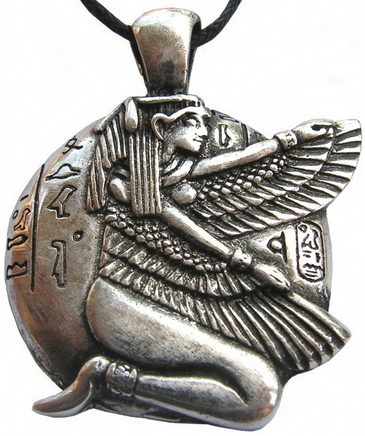
Essential Symbols and Their Interpretation
Below are described the most frequently appearing motifs on Egyptian pendants and their meaning in the mind of the wearer.
Eye of Horus (Udjat)
Function: protection, healing, and restoration.
The stylized Eye of Horus, with its precise lines, represented the healthy eye recovered after the violent conflict between Horus and Set. Wearing an Eye of Horus was to ask for health and safety. In funerary contexts, the eye guaranteed the deceased’s regeneration.

Scarab (Khepri)
Function: rebirth, protection against evil, and daily renewal.
The scarab is not an insect in Egyptian jewelry: it is the embodiment of the solar cycle. Associated with Khepri, the scarab symbolizes the constant recreation of the world. In many tombs, the scarab appears on the mummy’s chest as a promise of resurrection.

Ankh (Egyptian cross)
Function: life, vital energy, eternity.
The ankh is the key of life. It appears in the hands of gods and pharaohs as a symbol of dominion over existence. An ankh-shaped pendant was equivalent to carrying a symbolic contract with vitality and immortality.
Djed Pillar and Isis Knot
Function of the Djed Pillar: stability, Osiris’s backbone to ensure the deceased’s integrity.
Function of the Isis Knot (Tet): maternal protection and rebirth, related to Isis’s healing powers.
The Sons of Horus and Protective Deities
The four Sons of Horus, represented with distinct heads, guarded internal organs and were sewn into bandages. Amulets featuring Bastet, Bes, Taweret, or Hathor fulfilled specific functions: defense of the home, protection during childbirth, or blessing of fertility.
Materials, Colors, and Their Language
The selection of metal, stone, and color was not merely aesthetic: each element added a symbolic layer to the pendant. Below is a comparative table to better understand these choices.
| Material | Symbolic Meaning | Physical Properties and Use | Examples |
|---|---|---|---|
| Gold | Divinity, incorruptibility, sun | Malleable, durable, status symbol; used in royal pieces and offerings | Funerary mask, pectorals, inlays |
| Faience | Life, fertility, rebirth (green/blue) | Lightweight, economical; easy to mold and glaze; common in amulets | Scarabs, necklace beads, small plaques |
| Lapis Lazuli | Royalty, sky, eternity | Hard, intense blue tone; imported, high value | Pectoral inlays, beads |
| Turquoise | Joy, purity, protection | Semi-precious stone with blue-green hue; used in inlays | Pectorals and necklaces |
| Carnelian / Red Jasper | Vital energy, blood, strength | Bright red color; associated with action and life | Seals, beads, and pendants |
| Glass | Imitation of gems, accessibility | Allows varied color palettes; cheap compared to natural stones | Inlays and imitation pieces |
Masterful Goldsmithing Techniques and Production
Egyptian artisans achieved extraordinary levels in goldsmithing. Noteworthy techniques include lost-wax casting for gold pieces, the inlay of glass and stone fragments, and the mass production of faience amulets using molds.
To create faience beads and amulets, a string was often used as a core that, when fired, burned away leaving a hole for stringing. Inlays required patience: small polished fragments fit together like a mosaic within a metal setting.
Egyptian Pendants Today: Replicas, Reinterpretations, and Legacy
Contemporary fashion has borrowed motifs and chromatic palettes from ancient Egypt, transforming sacred symbols into pieces that connect aesthetics and spirituality. Replicas seek to recreate not only the form, but also the feeling of carrying an object charged with history.
When comparing a replica with an archaeological piece, the difference in patina, wear, and the execution of inlays is appreciated. Even so, replicas allow collectors and enthusiasts to relive a fragment of that millenary narrative.
Funerary Finds and the Science That Reveals Them
The use of amulets in mummies was systematic and symbolically patterned. The Book of the Dead and other funerary texts dictated the placement and functionality of certain objects, demonstrating a precise ritual intent.
Today, computed tomography (CT) allows “unwrapping” mummies without damaging them, revealing the exact location of amulets. These studies confirm that the placement was not accidental: each amulet fulfilled a protective or restorative function within the elaborate plan for the deceased’s resurrection.
Archaeological Examples That Speak
- Tutankhamun’s tomb: a set of pectorals, amulets, and a mask that illustrate the height of royal jewelry.
- Finds from the 12th Dynasty: diadems and pectorals showing technical precision in gold and stones.
- Mummies with faience bead networks: coverings that incorporated dozens of amulets in intentional arrangement.

Iconography and Canon: How Figures Were Represented
Egyptian iconography adhered to canons: profile for the head and limbs, frontal for the shoulders and eyes. This convention is also reflected in pendants, where stylization provides symbolic legibility.
Scenes could narrate daily life or the journey to the Afterlife, and in the confined space of a pendant, every line and color told a story. Understanding this visual language is key to interpreting its original function.

How to Read a Pendant: Practical Keys
If you observe an Egyptian pendant, follow these steps to decipher it:
- Identify the central motif (Eye, Ankh, Scarab, Djed). That symbol is the first clue to its function.
- Observe the materials and colors: green/blue suggests regeneration; gold, divinity; red, strength or protection against dangerous forces.
- Locate inscriptions or names: many scarabs and funerary amulets bear names that guarantee personal protection.
- Evaluate the technique: fine inlays and lost-wax casting indicate high-quality pieces and possible royal use.
Comparative Table: Uses and Contexts
| Use | Context | Examples of Motifs |
|---|---|---|
| Daily Protection | Living people, children, sacred animals | Eye of Horus, Bastet, Bes |
| Ritual and Status | Pharaohs, priests, ceremonies | Usekh collar, pectorals, ankh |
| Funerary | Mummies, offerings, bead networks | Scarab, Sons of Horus, Djed Pillar |
Conservation and the Passage of Time
The dry conditions of the Egyptian desert have preserved many pieces to this day. However, modern interpretation requires caution: patina, adhesive residues, and fractured inlays are part of the material history that specialists must read.
Current archeometry (CT, spectrometry, petrographic studies) allows determining the provenance of materials and techniques, enriching the narrative about each piece.

The Link Between History, Symbol, and Contemporary Design
Egyptian motifs have survived due to their powerful visual language. Modern designers reinterpret these symbols, maintaining their conceptual load and adapting them to new materials and formats.
This continuity demonstrates that, beyond their beauty, Egyptian pendants contain archetypes that continue to resonate: protection, rebirth, and the search for meaning in the face of the unknown.
For those who behold them today, an Egyptian pendant is an invitation to imagine: on the edge of the Nile wind, an artisan fits a fragment of blue glass into gold, and with that gesture offers a bridge between the earth and the gods.
By wearing or contemplating one of these pendants, you reclaim a portion of that ancient narrative and become, for an instant, a guardian of a tradition that defies time.
VIEW MORE EGYPTIAN PENDANTS | VIEW MORE PERIOD PENDANTS | VIEW BEAUTIFUL MEDIEVAL JEWELRY


